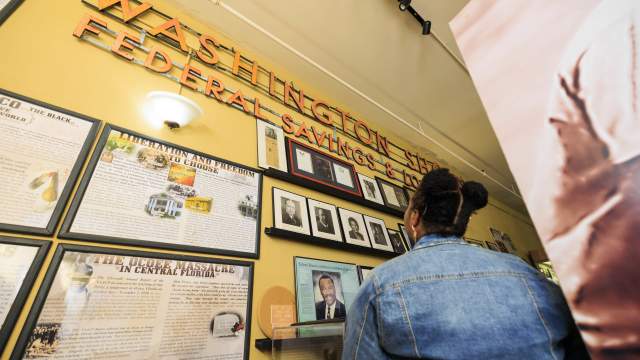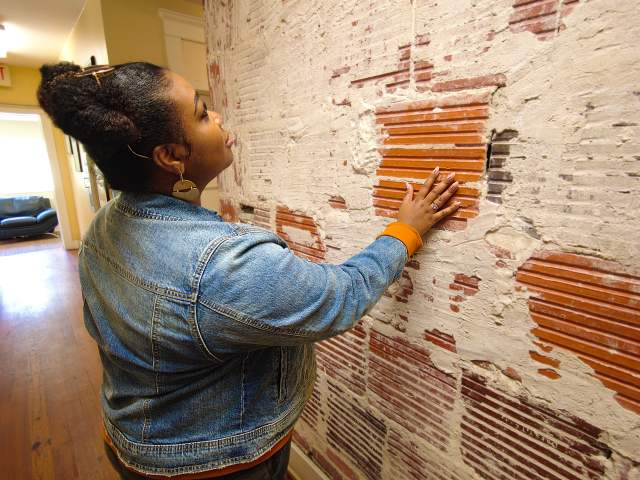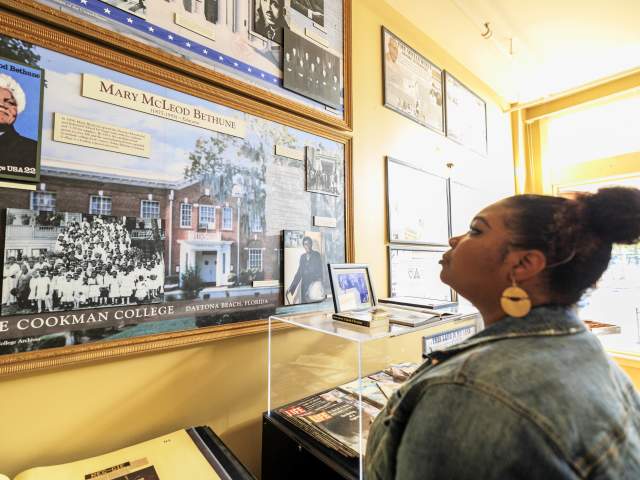Instagram influencer Katrina Dandridge visits downtown’s Wells’Built Museum.
Part two of a series. Read part one of “A Day of Historical Vibes & Black Pride” by Katrina Dandridge
I love historical structures and was so excited to find one right in the heart of downtown Orlando: the Wells’Built Museum of African American History & Culture, right across the street from the Kia Center near Church Street in downtown’s Parramore district. But what started off as a planned self-guided visit to the historic venue ahead of Black History Month ended up being a once-in-a-lifetime experience … because upon entering the museum, and to my surprise, I was greeted by Florida state Senator Geraldine Thompson.
Discover: Black History Month in Orlando
Not only is Thompson a member of the Florida House of Representatives, District 15, but she is also the founder of the Wells’Built Museum. I was nervously excited to sit down and chat with Senator Thompson about this amazing contribution to the culture. She spent nearly 30 minutes with me, providing a personal history lesson via an in-depth exploration of the Parramore community’s rich heritage. I was left awestruck by our chance meeting and will never forget my afternoon with this phenomenal woman.
Read my conversation with Senator Thompson below, and make time to visit this famous landmark the next time you’re in Orlando.
An Afternoon With Florida State Representative Geraldine Thompson
Katrina Dandridge: Tell me about this place. Where are we?
Florida state Senator Geraldine Thompson: You’re in a former hotel that was Black owned and operated. The owner [Dr. William Monroe Wells] was one of [Orlando’s] first African American physicians, who came here in 1917. He graduated from Meharry Medical College in Nashville, Tennessee, and learned about Orlando in the newspaper — and decided he would come and open a medical practice.
Discover: African American History & Culture in Orlando
When he got here, he found there was very few cultural outlets, and so he opened what was called the South Street Casino. It was not a gambling establishment; it was a performance hall. He booked big bands [like] Count Basie, Lionel Hampton and Billie Holiday to perform at the South Street Casino. When they finished entertaining, they had no place to stay. So, he applied for a building permit from the city of Orlando in 1926. [He] couldn’t get loans from banks to actually build the hotel. So, he self-funded [the project].

[Wells] used the revenue from his medical practice and from the South Street Casino to actually pay for the construction of the hotel, which opened in 1929. He named it for himself and called it the Wells’Built…
This facility is one of the few structures that were listed in the national directory called [The Negro Motorist] Green Book. It was the subject of an Academy Award-winning movie called Green Book. It was actually compiled by a Black postal worker in Harlem. When people traveled throughout the South, particularly African Americans, they didn’t know where they could stop and where they will be welcomed, where they will be safe — and so he put together this directory that people would take with them. [The Negro Motorist Green Book] was published from 1936 until 1966.

After the Civil Rights Act was passed, people could legally stay wherever they wanted to stay. Because of the listing in The Negro Motorist Green Book, a national clientele came to the South Street Casino, which was part of the Chitlin’ Circuit. [It] was named for a route where you can stop and pork intestines, which were called chitlings, would be on the menu! So, the South Street Casino was part of the Chitlin’ Circuit, and it was located right next door to the Wells’Built hotel, which is where we are now.
KD: Wow! Such history. I didn’t realize [Dr. Wells] was a physician!
Senator Thompson: Yes — medical doctor. When he came [to Orlando] in 1917 there was only one other African American physician, Dr. J.B. Callahan, who came in 1908. Now if you can think about the fact that Dr. Wells arrived here in 1917, and the next year there was the influenza pandemic. […] But white physicians did not treat Black patients during that time. So, you had two Black physicians who had to treat [Orlando’s] entire African American community during the influenza pandemic.
KD: And was it a large community for the most part?
Senator Thompson: Certainly not anything equivalent to what it is now. But you had this community which is called Parramore — and Parramore was designated as a residential area, commercial area etc. for, at the time, Negroes, by the mayor of Orlando who was [James B.] “Buck” Parramore. Buck Parramore was a Confederate general and after the Civil War, he came to Orlando.

A lot of the [Black] people who came to Orlando worked in the citrus industry or they tended children, they washed clothes, cleaned houses — that kind of work. Their employers wanted them to be close, but did not want them in the same community. There was a separate community called Parramore named for the mayor. It has maintained that name.
So, yes, [Dr. Wells] was a medical doctor. For 40 years he treated African Americans in this community.
The number of African Americans began to grow primarily because of the railroads. That was a new method of transportation. African Americans were hired to lay the rails for the railroads. In 1880, the railroad came to Orlando. The depot was built where people could get on the train, get off the train, and buy tickets or whatever. The depot was located on a street called Church. That stop became known as the Church Street Station. People would come, and the community began to grow.
Pretty soon, Parramore became oversaturated, and people began to move west. There were public housing developments. Griffin Park housing development was one of the first, and then you had the Carver Court public housing. People moved even further into Washington Shores.

KD: Wow! Church Street? So, like right around the corner from here, right?
Senator Thompson: Yes! Right around the corner! And it’s still called Church Street Station.
Now the station — the depot — has actually moved further. It’s on Sligh now down by the hospital. But if you go to Church Street Station, you will still see the depot is still there. The building is now [Hamburger Mary’s]. But the building is still there, and you see the railroad right there. For many years there was a railroad car that was on the tracks, and people could actually look at the car — the rail car.
KD: Nice. Think of how many people come to this area and go to Church Street and have no idea what the history is behind that. That’s amazing to know. So, tell me then, what was the inspiration to transform this from a hotel to a museum. When did that start? How did it come about?
Senator Thompson: After the Civil Rights act was passed, people could legally go wherever they could afford to go. Because they had been denied access, they were curious about other places. People no longer came and checked [into] the Wells’Built building, and it fell on hard times. It was abandoned and it was boarded up.

I did research and learned about it. I was an administrator at Valencia College [at the time]. One of the things that I did was to prepare for Black History Month every February. I interviewed some of the pioneers here in Orlando and learned about the Wells’Built. I thought, “What a wonderful place to actually house a museum where we could bring a lot of the artifacts and memorabilia that we had collected to display for students.” You could only see it when the college was open — and generally only in February. It’s information that’s relevant 365 days a year.
I wanted a place where people could come without being hampered or limited by the operation of the college. Working with a board of directors, we acquired the Wells’Built and got funding to restore it. That was a three-year process because the building had been abandoned, the roof was leaking, termite infestation, water intrusion — so, we had to put in new flooring and dry wall. There was no air conditioning in the building, so we had to put in air conditioning. We had to bring it up to code. We opened in celebration of Black History Month in February of 2001. So, we just celebrated our 20th anniversary.

KD: And what a cool collection it is. I saw some really cool jerseys back there. Tell me what was the first piece — if you could remember — that was brought in.
Senator Thompson: Oh, my goodness! Hmm… there is a lot. I think probably the African masks were among the first things that we brought here. Because people think that our history began with slavery in America. Our history began in Africa. We wanted people to connect those of us in the United States with our ancestors in Africa. We brought a lot of African masks, African instruments, musical instruments, and those were among the first things that we brought.
KD: I like that! Back to our roots, right? What a great place to start. What is your personal favorite piece here?
Senator Thompson: Well, that changes because we have acquired quite a lot of things, and now one of my favorites is the display on Dr. Mary McLeod Bethune. That is my favorite because in addition to being the founder here, I’m a member of the Florida legislature, and the Florida legislature voted to be represented in [The National Statuary Hall Collection in the U.S. Capitol] in Washington, D.C., by Dr. Mary McLeod Bethune. The only state in the nation to vote to be represented in Statuary Hall by an African American woman.

KD: Wow Amazing! What else?
Senator Thompson: The bedroom.
KD: The bedroom?
Senator Thompson: Yes! [Laughs.] We have a bedroom. All of the guests’ bedrooms, when this was a hotel, were upstairs. You would come and check in — [gestures to reception area].
KD: So, this would be the actual check-in area right here?
Senator Thompson: Yes, right here. You come in, check in, and then you’d have to go back outside because there were no stairs to get you up to the bedroom. You go back outside, and you go up the stairs on the side of the building. There is a bedroom that we set up as if it were in the 1920s, 1930s, and we have authentic furniture from that period. So, that is one of my favorites, the bedroom that is still there.
KD: I need to check that out!
Senator Thompson: Yes, you do.

KD: Is anything here donated from the community? How do you build something like this?
Senator Thompson: We do have a mixture of things that are donated. For example, those dolls were donated by a friend who had traveled to Africa and had purchased them. She wanted them to have a greater visibility than just in their home. So, she donated them to the museum.
We have art that was donated, we have things like the furniture that you see in the bedroom upstairs that I purchased. We have a carving here — the sankofa bird. Sankofa is an African term that means “go back and fetch it.” We have left behind so much that I think sankofa is a very appropriate term for what we are doing here — working to go back and fetch it. The sankofa bird, and many people use that, flies forward but his head is turned back to retrieve things that have been left behind. I purchased the sankofa bird in Trinidad.
KD: Really? Wonderful! I love that! So, when are you open to the public?
Senator Thompson: Monday through Friday 9 to 5, and by appointment on Saturday. Saturdays are usually reserved for groups that want to come. They make reservations, and we make sure that we have staff on those Saturdays when we have groups that are going to come.

KD: One last question. When people come to visit you, what is the one thing you would like them to take away from their experience?
Senator Thompson: That this is a historic place. It is listed on the National Register of Historic Places because of the historically significant people who lodged here during the days of segregation when they had no other options.
The Wells’Built is very much like the Lorraine Motel in Memphis, Tennessee. The Lorraine Motel is where [Dr. Martin Luther King Jr.] unfortunately was assassinated. When he traveled to Memphis, he would always stay at the Lorraine Motel. Not because it was the greatest place, but it was the only place because of segregation.
I’d like people to know that this is a historic structure listed on the National Register. The Green Book — we have a section here that shows the Wells’Built listing in the Green Book. We highlight and we elevate the history of African American people, and that has not been done until we really started working 20 years ago.

KD: Absolutely! Thank you for your contribution. Because this is needed. It’s something that I think the average person doesn’t even think about. It is nice to be able to come here and it be something that is tangible — I can hold it, I can look at it, and really take in the history. That’s amazing! Thank you! So, show me around a little bit…
Stay Connected to Orlando
You never know what we’ll dream up next. Connect with Visit Orlando’s Vacation Planning Services for free, personalized assistance, and follow us on Facebook, X, Instagram, TikTok, Pinterest, Threads and YouTube for valuable offers, exclusive tips, fresh attractions and the latest events. You can also subscribe to our eNewsletter for more information from Orlando: Theme Park Capital of the World.
Have feedback about this blog? Let us know.
